The Importance of Materials Management, Planning & Scheduling
The definition of the maintenance function is to repair or maintain equipment in the shortest amount of time, at the optimal cost, and with the most minimal disruption to production. In order to achieve that ideal state of maintenance, here’s what you will learn:
- Current State of Maintenance Programs and Storerooms
- World Class Concepts for Storerooms
- Tactical Best Practices for World Class Storeroom Operations
- Fundamental Elements of Good Maintenance Planning & Scheduling
Current State of Maintenance Programs and Storerooms
Maintenance Programs
The act of maintenance is a recurring activity, meaning that you’ll be back on that equipment. That frequency could be random – it could be tomorrow, it could be next week, it could be three years from now, but the act of maintenance is a recurring activity. Suffice to say that it is important that when job plans are written, they are written well the first time.
What is wrong with the current state of maintenance programs?
- Craftsman, supervisors, planners, and engineers do not sign out or document removal of materials
- No established budget or process for obsolete materials
- No formalized process for equipment installation
- Changes made to the equipment without proper documentation
- Lack of communication
Maintenance Storerooms
Often, people go into the storeroom and they take parts and they don’t sign them out. That causes frustration for everyone because when technicians or planners go to the storeroom, the CMMS system says that they have a part in there, and they go there and it’s not there.
Unless we’re looking at RFID, there is not really a system out there with the capability of knowing if somebody went in the storeroom last night and took a part out of there without signing it out. Obsolescence seems to be a big issue.
What is wrong with the typical storeroom?
- Out of the way – poor ease of access (out of sight, out of mind)
- Helpless in the decision making process
- Accountable without authority
- Inadequate staffing in terms of numbers or qualifications
- Too much inventory
- Too little inventory
- Poor service level
- Always out of stock
- Not enough space – overcrowded
Current Practices in Storerooms Based on Assessments:
- Less than 25% of maintenance storerooms in the US and Canada have Standard Operating Procedures (SOPs) for their storeroom
- Only 10-15% of storerooms have and obsolescence plan and budget
- 10-35% rate their suppliers on performance
- Less than 50% of parts in the storeroom are turned over in a 12 month period and many storerooms do not review inventory at all
- 58% of typical storeroom inventory hasn’t been touched in over 3 years. Of the remaining 42%, 60% is considered excess
- Less than 40% of all storerooms pick, stage, and kit their work orders effectively
- 40-50% of Maintenance Planners fail to use failure analysis to plan future maintenance requirements
World Class Concepts for Storerooms
Companies are under ever-increasing competitive pressure to move to “World Class” status by improving quality, reducing costs, increasing equipment uptime, cutting inventory, increasing Overall Equipment Effectiveness (OEE) and reducing energy pollution.
11 Expected Outcomes of World Class MRO Operations
1. Optimize inventories
2. Increase inventory accuracy
3. Identify and remove obsolete materials
4. Accurate min/max levels
5. Identify overstock materials
6. Standard Operating Procedures (SOP)
7. Reduce emergency buys
8. Reduce stock-outs
9. Increase operational efficiencies and effectiveness
10. Reduce search and downtime
11. Supplier partnerships
What Separates the Best from the Rest?
- A Proactive Approach – Preventive and Predictive Maintenance represent 60% or more of all maintenance activity
- The Capability to Plan and Schedule Work – Greater than 80% of all maintenance work is pre-planned
- Effective Supervision / Leadership
- Appropriate Maintenance Skills
- Effective Materials Control
- Fewer Layers of Management… leaner organizational structures
- Decision-making is pushed down into the organization
- Activity is more “worker-directed” – mechanics are allowed and encouraged to use skills and experience to solve problems
- Strong commitment to training and development
- Management believes in employee involvement and participative problem-solving
- More cross-functional cooperation between Maintenance and Production
- Focus on Performance Measurement and Continuing Improvement – especially downtime
- Computerized Maintenance Management System
- Supported by management and used consistently
- Managers view their mission as “continuous process improvement” rather than “keep it running”
- Production employees assume increasing responsibility for some maintenance
It is critical to fix things, not just work on them. We have effective leadership and supervision on the shop floor, and on multiple levels of the organization. Organizations should establish or adopt a very robust training program particularly with the next generation of maintenance technicians coming in, and an organized storeroom. We cannot expect to have a world class maintenance organization that is not supported by a world class storeroom.
Even among the best, there was still 15-20% area of opportunity for improvement. Top maintenance performance requires an overall commitment, absolutely positively ranks right up there with any company’s safety and quality directives.
Typical Return on Investment from Achieving World Class Maintenance
- Repair expenses increase by 30% in the first 12-18 months
- Expenses then decline 60%-80% below original levels after 24-30 months
- Equipment breakdowns decline 50%-60%
- Equipment downtime declines 60%-80%
- Availability increases 10%-20%
- Spare parts inventories decline 20%-35%
Equipment Bill of Materials (EBOMs)
Equipment Bill of Materials is a list of component parts in a piece of equipment that includes part numbers, descriptions, quantities, and levels. EBOMs are a necessary element of Reliability Excellence® and are generally very accurate. EBOMs are typically are not overlooked or ignored, as having an accurate EBOM directly affects the bottom line (production). Less than 30% of the industrial firms surveyed have an accurate Bill of Material.
To establish a reliable environment, having an accurate Bill of Materials is critical. It’s a list of all the components that make up a piece of equipment, also referred to as a multilevel bill of materials or parent-child relationships. This data is all loaded up in your CMMS so you can go back and reference it and improve the efficiency of your planners.
Objectives and Goals of Equipment Bills of Material
- The objective is to develop an accurate and complete listing of the components of a particular piece of equipment as a central source of information that supports product costing, inventory control, engineering and tradesmen
- The goal is to achieve 98% or better EBOM on capital equipment
- Correct information about components in equipment
- All assets are identified and listed in CMMS
- All replacement parts are linked to equipment assets
- All manuals and prints readily available in one centralized area
- Capture “Tribal Knowledge”
- Capture job knowledge and instructions
- Capture part substitution as an alternate part in the EBOM
Tactical Best Practices for World Class Storeroom Operations
What do some of the best organizations do to establish world class storeroom operations? It’s important to always improve, reduce, and get better. Below are some tactical ways to get started on the path toward a world class storeroom.
- Set up new items using a standardized form and format (item #, part description, where used, etc.)
- Use an ABC classification strategy
- Cycle count daily or weekly to find root cause discrepancies
- Get obsolescence reviewed and budgeted by cross-functional members
- Kit parts to ensure all items are staged and accounted for and available 24/7
- Manage parts purchasing to determine correct inventory levels
- Manage materials requisitioning using a standardized form
- Receive parts in a designated area, perform a visual inspection for damage, and match BOL, packing list, and PO
- Issue all materials to a work order
- Ensure repair or replace parts are returned to a designated area and tagged
- Develop a materials lay-up program and a scheduled PM program to manage assets
- Ensure the parts being returned to supplier are returned to a designated area with appropriate paperwork
- Ensure the parts being returned to stock are returned in good condition and to a designated area
- Control inventory levels using reorder points (ROP), Economic Order Quantity (EOQ) and Order On Request (OOR) min/max
- Assure right parts, right quantity, right time
- Evaluate critical spares based on data analysis (FMEA, RCM, etc.) to limit catastrophic downtime
- Determine salvage value for whether you want to sell parts back to supplier, sell on e-commerce portals, or donate
- Develop a Vendor Managed Inventory (VMI) / consignment strategy to reduce inventory levels and increase turns
- Data scrub to validate CMMS and improves effectiveness of overall operation
- Problem solve to determine whether the process failed, or someone failed to follow the process
Fundamental Elements of Good Maintenance Planning and Scheduling
Maintenance planning and scheduling is an allocation of needed resources and materials in the sequence in which they are needed, in order to allow an essential activity to be performed in the shortest time at the least cost. It is a tool for maximizing value-added work. Maintenance planning relies on work order systems, timekeeping systems, equipment identification, CMMS, preventive and predictive maintenance programs, and storeroom control.
How is planning different than scheduling? Planning is the allocation of resources and materials – it is the “what” and the “how.” Scheduling is the assignment of how many planned jobs – it is the “when.”
What is Maintenance Planning?
Maintenance planning decides what, how and time estimate for a job. Planning has the most profound effect on timely and effective accomplishment of maintenance work. Avoiding delays is the basic goal of planning and scheduling. For every hour of effective planning, the typical return is three hours in maintenance labor time saved or an equivalent savings in materials and production downtime.
By planning and scheduling maintenance, we could start drilling into some more educated guesses on how long that equipment should be expected to be down for. So the goal is getting the equipment repaired as quickly as we can in the shortest period of time, that’s optimal costs, that’s the least disruptive to production.
Advantages of Planned Work
- Work and workload measurement
- Accurate promises or commitments
- Better methods and procedures
- Establishment of Priorities
- Monitoring of job progress
- Coordination of labor, materials, and equipment
On the other hand, unplanned work can be 3 to 4 times more expensive than planned work, and often requires more overtime. It leads to frustration and is typically more disruptive to the manufacturing process.
Criteria for Planning Jobs
- A quality, cost, or performance standard must be met
- A job is being performed to satisfy a manufacturer’s warranty
- Cost and performance are being measured – mean time between failures and mean time to repair are very good metrics to understand on planning efficiency and effectiveness.
Procedure for planning maintenance jobs
1. Review and analyze work order
2. Visit the job site
3. Determine basic information
4. Plan the work
5. Determine availability of materials
6. Complete work plan
7. Schedule work request
8. Follow-up on the work order
Typical Planning Duties
- Review work requests for each significant piece of information
- Assign work requests that need planning and material to the planning backlog
- Enter work orders into CMMS to accept charges and close when complete
- Facilitate maintenance activity with production
- Establish and maintain equipment parts catalog, equipment history, storeroom, min/max levels
- Review actual vs. plan on completed work orders
- Coordinate special programs (i.e. ladder inspections, equipment surveys)
- Identify recurring maintenance problems
What is Maintenance Scheduling?
Maintenance scheduling is the assignment of planned jobs into a time period, the activation of the planning period, and the orderly progression of work. During scheduling meetings, teams establish the priority with production. But at the end of the day, there needs to be an understanding of who owns the maintenance schedule. Production teams are able to schedule the time to take the equipment down, they’re the ones who are going to work with the maintenance crew to make sure that we’ve got the resources available to get in there on the day that it’s scheduled.
Typical Scheduling Duties
- Prepare weekly schedule and facilitate weekly scheduling meeting
- Prepare daily schedule for Maintenance Supervisor (without assigning personnel to job- this is the supervisor’s responsibility)
- Receive and process daily schedule and late work report from previous day
- Manage Supplemental Maintenance (i.e. contractors) for skill levels, monitor craft backlog, establish trigger points for decision making and manpower smoothing
- Manage the maintenance budget
Summary
It is important to have cross functional activities, maintenance and operations working together. This includes having morning meetings to establish priorities. Maintenance planners should work with the storeroom operation to review min/max levels, determine if the right parts are in there, put kits together, and write good job plans for the maintenance technicians. Organizations will move away from trying to reduce their inventories, to move towards optimal inventory levels and how to maintain that optimal level.






